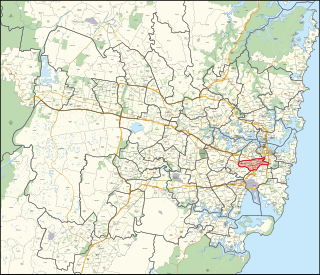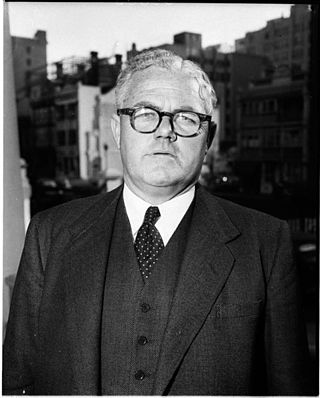Related Research Articles

Upper Hunter is an electoral district of the Legislative Assembly in the Australian state of New South Wales. The seat is currently held by Dave Layzell for the National Party after he was elected at a by-election to replace Michael Johnsen.

Argyle was an electoral district for the Legislative Assembly in the Australian State of New South Wales from 1856 to 1904, including Argyle County surrounding Goulburn. The town of Goulburn was in Southern Boroughs from 1856 to 1859 and then Goulburn. The district had previously been represented by the district of County of Argyle in the partially elected Legislative Council.
Moruya was an electoral district of the Legislative Assembly in the Australian state of New South Wales from 1894 to 1904, named after Moruya. It was created from parts of the districts of Eden and The Shoalhaven. Its only member was William Millard, who held it for the Free Trade Party until 1904 when it was replaced by The Clyde.
The Clyde was an electoral district of the Legislative Assembly in the Australian state of New South Wales which was creating in 1904, named after the Clyde River and replacing Moruya. It was abolished in 1913 and replaced by Bega.
Allowrie was an electoral district of the Legislative Assembly in the Australian state of New South Wales first created in 1904 and replacing Shoalhaven and part of Moruya. Its name appears to be Aboriginal, meaning "pleasant place near the sea" or "high place near the sea" and may be the source of the name Illawarra. In 1920, with the introduction of proportional representation, it was absorbed into Wollondilly, along with Wollongong.
St Vincent was an electoral district of the Legislative Assembly in the Australian state of New South Wales existing from 1856 until 1859. It was named after St Vincent County. It included Batemans Bay and the Jervis Bay area. It was largely replaced by Shoalhaven, while some of the southern portions became part of Braidwood and Eden.
Rous was an electoral district of the Legislative Assembly in the Australian state of New South Wales, created in the 1904 re-distribution of electorates following the 1903 New South Wales referendum, which required the number of members of the Legislative Assembly to be reduced from 125 to 90. It consisted of parts of Lismore and The Tweed. It was named after Rous County, between the Tweed and Richmond Rivers and Henry John Rous, who explored the rivers. In 1913, it was replaced by Byron.
Namoi, known as The Namoi until 1910 was an electoral district of the Legislative Assembly in the Australian state of New South Wales, created in 1880 and named after the Namoi River. It elected two members between 1891 and 1894. In 1894 it was abolished and partly replaced by Narrabri. In 1904, with the downsizing of the Legislative Assembly after Federation, Namoi was recreated, replacing Narrabri and part of Gunnedah. Between 1920 and 1927, it largely absorbed Gwydir and Tamworth and elected three members under proportional representation. In 1927, it was replaced by single-member electorates, mainly Namoi, Tamworth and Barwon. Namoi was abolished in 1950.
Lachlan and Lower Darling was an electoral district of the Legislative Assembly in the Australian state of New South Wales. It existed between 1856 and 1859, and was named after the Lachlan and Darling Rivers. It elected two members simultaneously. In 1859 it was replaced by Lachlan.

Newtown is an electoral district of the Legislative Assembly in the Australian state of New South Wales. It includes the inner Sydney suburbs of Redfern, Chippendale, Darlington, Eveleigh, Newtown, Enmore, Stanmore and Petersham and parts of Waterloo, Erskineville, Camperdown, Marrickville and Lewisham. It is held by Jenny Leong of the Greens.

Philip Henry (Pat) Morton was an Australian businessman and politician. Born in Lismore in Northern New South Wales to a prominent political family and educated at Lismore High School, Morton left school at fourteen to be employed in a legal firm, before branching out into various businesses. Moving to Sydney, Morton first entered politics in 1944 as an Alderman on Mosman Municipal Council, rising to be Mayor in 1946. Morton then entered the New South Wales Legislative Assembly on 3 May 1947, representing the Electoral district of Mosman for the Liberal Party.
Allowrie, an electoral district of the Legislative Assembly in the Australian state of New South Wales, was created in 1904 and abolished in 1920. The only member for Allowrie was Mark Morton.
Rous, an electoral district of the Legislative Assembly in the Australian state of New South Wales was created in 1904 and abolished in 1913.
The 1904 New South Wales state election involved 90 electoral districts returning one member each. The election was conducted on the basis of a simple majority or first-past-the-post voting system. There were two significant changes from the 1901 election, the first was that women were given the right to vote, which saw an increase in the number of enrolled voters from 345,500 in 1901, to 689,490 in 1904. The second was that as a result of the 1903 New South Wales referendum, the number of members of the Legislative Assembly was reduced from 125 to 90. The combined effect of the changes meant that the average number of enrolled voters per electorate went from 2,764, to 7,661, an increase of 277%. Leichhardt was the only district that was not substantially changed, while The Macquarie and The Murray districts retained nothing but the name.
Namoi, an electoral district of the Legislative Assembly in the Australian state of New South Wales had two incarnations, from 1880 to 1894 and from 1904 to 1950.
Shoalhaven, an electoral district of the Legislative Assembly in the Australian state of New South Wales was created in 1859 and abolished in 1904.
A by-election was held for the New South Wales Legislative Assembly electorate of Shoalhaven in January 1861 because John Garrett resigned to become a police magistrate at Scone. The by-election allowed John Robertson to return to the Legislative Assembly after the Legislative Council had passed the Robertson Land Acts, which would open up the free selection of Crown land.
Gough, an electoral district of the Legislative Assembly in the Australian state of New South Wales was created in 1904 and abolished in 1920.
Grenfell, an electoral district of the Legislative Assembly in the Australian state of New South Wales was created in 1880 and abolished in 1904.
A by-election was held for the New South Wales Legislative Assembly electorate of Shoalhaven on 21 August 1871 because Thomas Garrett resigned to accept appointment as a police magistrate at Berrima.
References
- ↑ Green, Antony. "Elections for the District of Shoalhaven". New South Wales Election Results 1856-2007. Parliament of New South Wales . Retrieved 28 November 2019.
- ↑ "Mr John Garrett (1805-1885)". Former members of the Parliament of New South Wales . Retrieved 10 June 2019.
- ↑ "Sir John Robertson (1816–1891)". Former members of the Parliament of New South Wales . Retrieved 18 April 2019.
- ↑ "Mr Thomas Garrett (1830-1891)". Former members of the Parliament of New South Wales . Retrieved 26 September 2019.
- ↑ "Mr James Warden (1820-1904)". Former members of the Parliament of New South Wales . Retrieved 10 June 2019.
- ↑ "Mr John Roseby (1835-1898)". Former members of the Parliament of New South Wales . Retrieved 14 June 2019.
- ↑ "Mr Frederick Thomas Humphery (1841-1908)". Former members of the Parliament of New South Wales . Retrieved 22 May 2019.
- ↑ "Mr William Fraser Martin (1834-1917)". Former members of the Parliament of New South Wales . Retrieved 26 June 2019.
- ↑ "Mr Philip Henry Morton (1862-1932)". Former members of the Parliament of New South Wales . Retrieved 16 June 2019.
- ↑ "Mr David Davis (1854-1927)". Former members of the Parliament of New South Wales . Retrieved 21 May 2019.
- ↑ "Mr Mark Fairlies Morton (1865–1938)". Former members of the Parliament of New South Wales . Retrieved 16 June 2019.
- ↑ Green, Antony. "1901 Shoalhaven". New South Wales Election Results 1856-2007. Parliament of New South Wales . Retrieved 29 March 2020.
